![[Previous]](../../../buttons/fprev.png)
![[Next]](../../../buttons/fnext.png)
DTC P2253: Heated
Oxygen Sensor Offset Circuit High Voltage
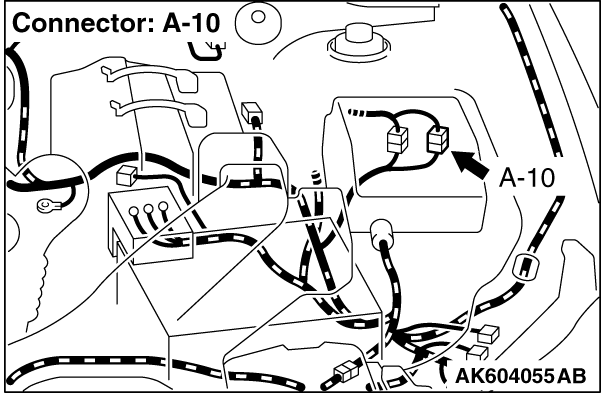

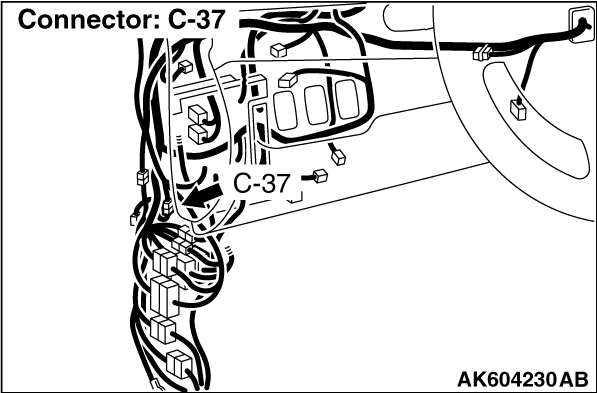
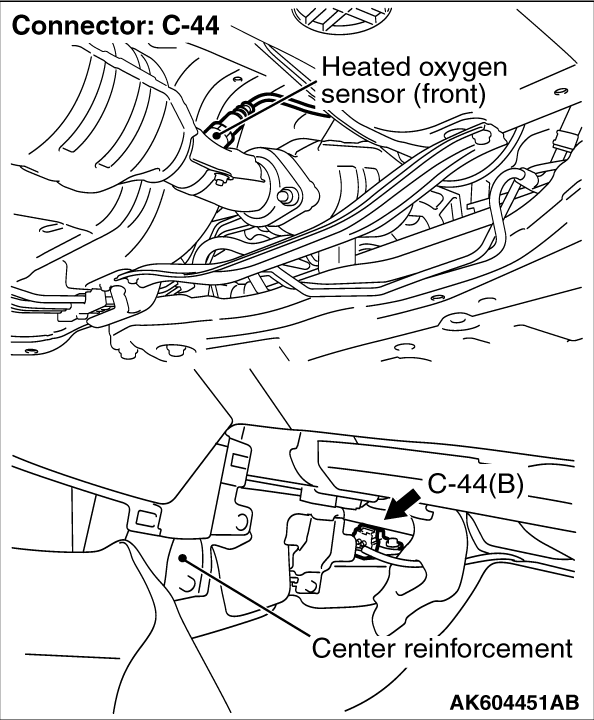

HEATED OXYGEN SENSOR OFFSET CIRCUIT HIGH VOLTAGE CIRCUIT
Refer to DTC P0131 -
Heated Oxygen Sensor (front) Circuit Low Voltage  .
.
Refer to DTC P0137 -
Heated Oxygen Sensor (rear) Circuit Low Voltage  .
.
CIRCUIT OPERATION
Refer to DTC P0131 -
Heated Oxygen Sensor (front) Circuit Low Voltage  .
.
Refer to DTC P0137 -
Heated Oxygen Sensor (rear) Circuit Low Voltage  .
.
TECHNICAL DESCRIPTION
- The ECM applies an offset voltage of 0.5 volt to the
heated oxygen sensor.
- The ECM checks for heated oxygen sensor offset voltage.
DESCRIPTIONS OF MONITOR METHODS
Heated oxygen sensor offset voltage is over specified
range.
MONITOR EXECUTION
MONITOR EXECUTION CONDITIONS (Other monitor and Sensor)
Other Monitor (There is no temporary DTC stored in memory
for the item monitored below)
Sensor (The sensor below is determined to be normal)
DTC SET CONDITION
Logic Flow Chart
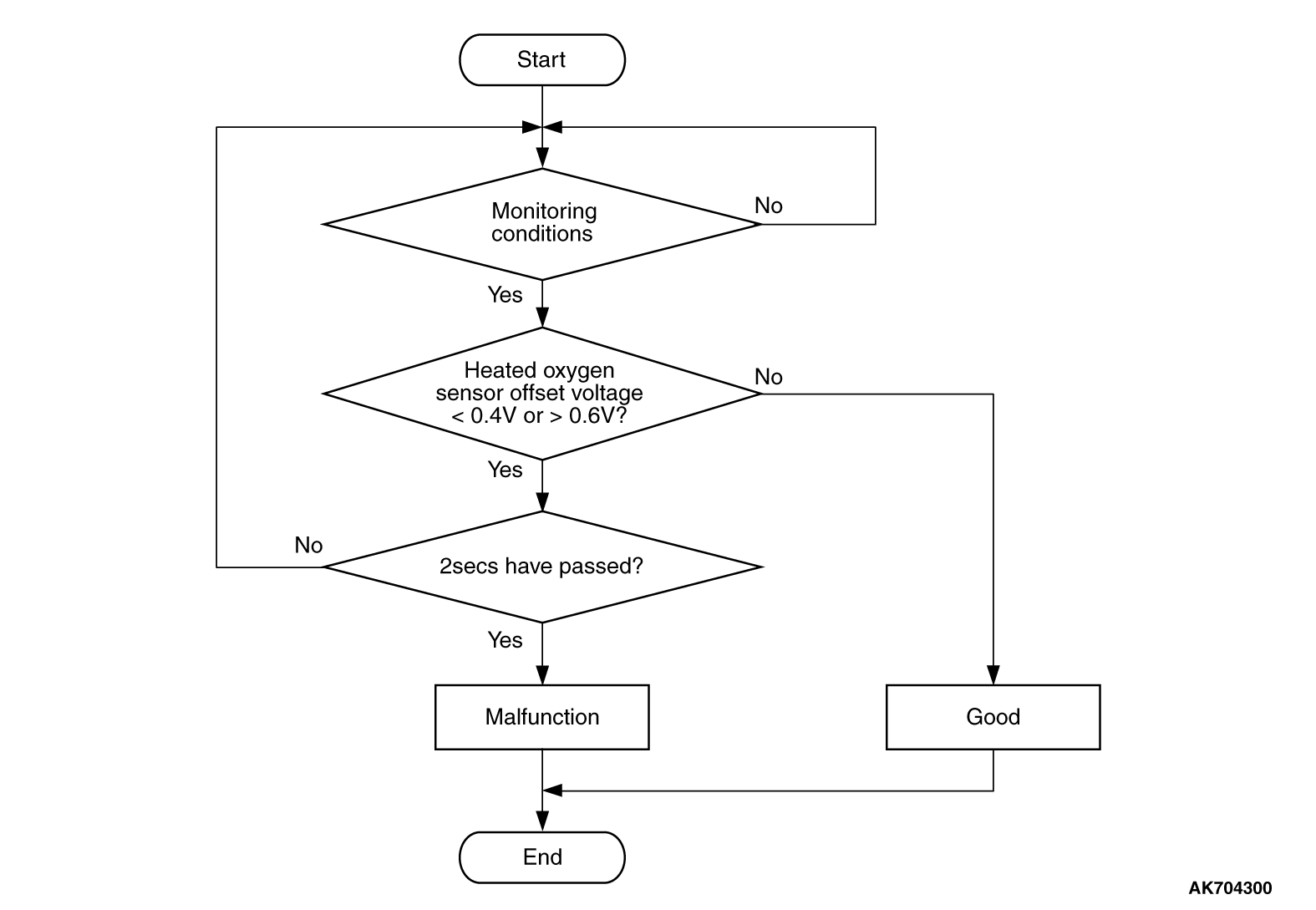
Check Condition
- More than 2 seconds have passed since the engine starting sequence was completed.
Judgement Criterion
- Heated oxygen sensor offset voltage is more than 0.6 volt for 2 seconds.
OBD-II DRIVE CYCLE PATTERN
Refer to Diagnosis Function -
OBD-II Drive Cycle -
Pattern
23  .
.
TROUBLESHOOTING HINTS (The most likely causes for this code to be set are:)
- Heated oxygen sensor (front) failed.
- Heated oxygen sensor (rear) failed.
- Shorted heated oxygen sensor (front) circuit or connector damage.
- Shorted heated oxygen sensor (rear) circuit or connector damage.
- ECM failed.
|
|
Required Special Tools:
- MB991958: Scan Tool (M.U.T.-III Sub Assembly)
- MB991824: V.C.I.
- MB991827: USB Cable
- MB991910: Main Harness A
- MB991658: Test Harness
- MB992110: Power Plant ECU Check Harness
|
|
|
STEP 1. Check harness connector C-44 at heated oxygen sensor
(front) and harness connector D-40 at heated oxygen sensor (rear) for damage.
|
|
|
Q.
Are the harness connectors in good condition?
|
|
|
 Go to Step 2. Go to Step 2.
|
|
|
|
|
|
 Repair or replace them. Refer to GROUP 00E, Harness Connector Inspection Repair or replace them. Refer to GROUP 00E, Harness Connector Inspection  .
Then go to Step 12. .
Then go to Step 12.
|
|
|
|
|
|
STEP 2. Check the heated oxygen sensor (front).
|
|
|
(1)Disconnect the heated oxygen sensor (front) connector C-44 and connect test harness
special tool MB991658 to the connector on the heated oxygen sensor (front) side.
|
|
|
(2)Warm up the engine until engine coolant temperature reaches 80°C (176°F)
or higher.
|
|
|
(3)Rev the engine for 5 minutes or more with the engine speed of 2,500 r/min.
|
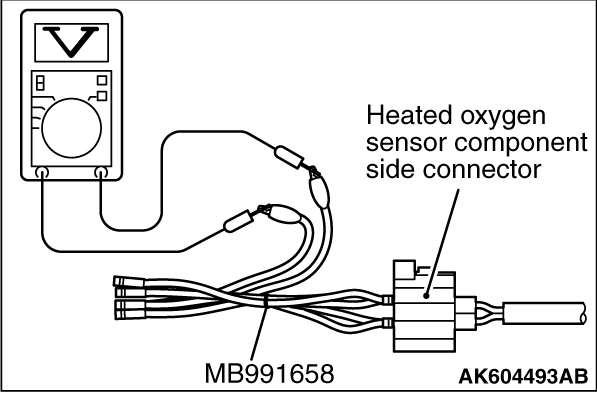
|
(4)Connect a digital voltage meter between terminal No. 3 and terminal No. 4.
(5)While repeatedly revving the engine, measure the heated oxygen sensor (front) output
voltage.
(6)Standard value: 0.6 -
1.0 V
| caution |
- Be very careful when connecting
the jumper wires;
incorrect connection can damage the heated oxygen sensor.
- Be careful the heater can be damaged if a voltage beyond 8 volts is applied to the
heated oxygen sensor heater.
|
| note |
If the temperature of sensing area does not reach the high temperature [of approximately
400°C (752°F) or more]
even though the heated oxygen sensor is normal,
the output voltage would be possibly low in spite of the rich air/ fuel ratio. Therefore, if
the output voltage is low, use a jumper wire to connect the terminal No. 1 and the terminal
No. 2 of the heated oxygen sensor with the positive terminal and the negative terminal of 8
volts power supply respectively, then check again.
|
Q.
Is the measured voltage between 0.6 and 1.0 volt?
 Go to Step 3. Go to Step 3.
 Replace the heated oxygen sensor (front). Then go to Step 12. Replace the heated oxygen sensor (front). Then go to Step 12.
|
|
|
STEP 3. Check the heated oxygen sensor (rear).
|
|
|
(1)Disconnect the heated oxygen sensor (rear) connector D-40 and connect test harness
special tool MB991658 to the connector on the heated oxygen sensor (rear) side.
|
|
|
(2)Warm up the engine until engine coolant temperature reaches 80°C (176°F)
or higher.
|
|
|
(3)Drive at 50 km/h (31mph) or more for 10 minutes.
|

|
(4)Connect a digital voltage meter between terminal No. 3 and terminal No. 4.
(5)Measure the output voltage of heated oxygen sensor under the following driving.
- Transaxle: 2nd speed
- Drive with wide open throttle
- Engine: 3,500 r/min or more
(6)Standard value: 0.6 -
1.0 V
| note |
If the temperature of sensing area does not reach the high temperature [of approximately
400°C (752°F) or more]
even though the heated oxygen sensor is normal,
the output voltage would be possibly low in spite of the rich air-fuel ratio.
|
| note |
When the vehicle is driven with high loads, the temperature of the sensing area of the
heated oxygen sensor is sufficiently high. Thus, it is not necessary to apply the voltage to
the heater.
|
Q.
Is the measured voltage between 0.6 and 1.0 volt?
 Go to Step 4. Go to Step 4.
 Replace the heated oxygen sensor (rear). Then go to Step 12. Replace the heated oxygen sensor (rear). Then go to Step 12.
|
|
|
STEP 4. Check harness connector B-108 at ECM for damage.
|
|
|
Q.
Is the harness connector in good condition?
|
|
|
 Go to Step 5. Go to Step 5.
|
|
|
|
|
|
 Repair or replace it. Refer to GROUP 00E, Harness Connector Inspection Repair or replace it. Refer to GROUP 00E, Harness Connector Inspection  .
Then go to Step 12. .
Then go to Step 12.
|
|
|
|
|
|
STEP 5. Measure the sensor offset voltage at ECM connector B-108 by
using power plant ECU check harness special tool MB992110.
|
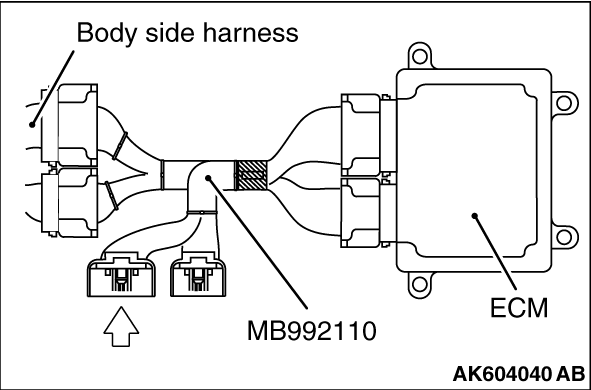
|
(1)Disconnect all ECM connectors. Connect the power plant ECU check harness special tool
MB992110 between the separated connectors.
(2)Turn the ignition switch to the "ON" position.
|
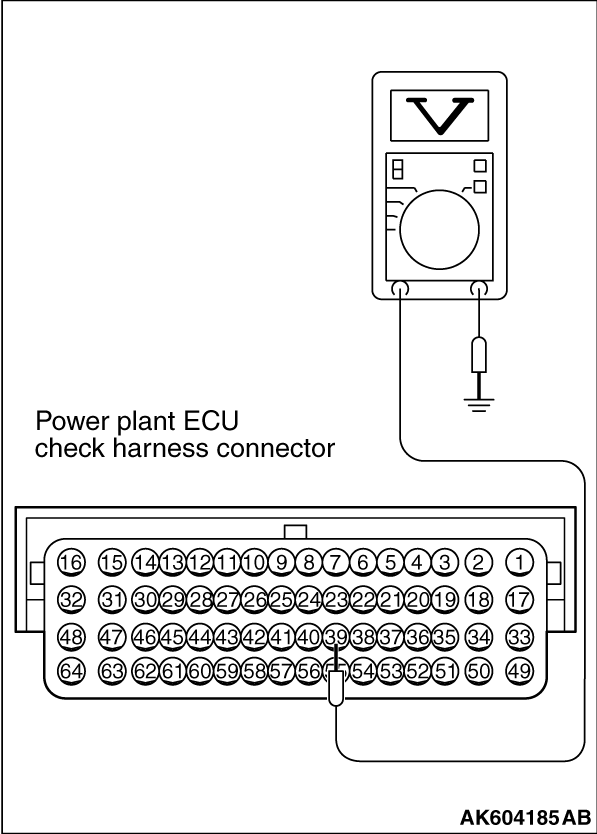
|
(3)Measure the voltage between terminal No. 39 and ground.
- Voltage should be between 0.4 and 0.6 volt.
(4)Turn the ignition switch to the "LOCK" (OFF) position.
Q.
Is the measured voltage between 0.4 and 0.6 volt?
 Go to Step 8. Go to Step 8.
 Go to Step 6. Go to Step 6.
|
|
|
STEP 6. Check for short circuit to power supply between heated oxygen
sensor (front) connector C-44 (terminal No. 4) and ECM connector B-108 (terminal No. 39).
|
|
|
| note |
Check harness after checking intermediate connector A-10. If intermediate connector is
damaged, repair or replace it. Refer to GROUP 00E, Harness Connector Inspection  . Then
go to Step 12. . Then
go to Step 12.
|
|
|
|
Q.
Is the harness wire in good condition?
|
|
|
 Go to Step 7. Go to Step 7.
|
|
|
|
|
|
 Repair it. Then go to Step 12. Repair it. Then go to Step 12.
|
|
|
|
|
|
STEP 7. Check for short circuit to power supply between heated oxygen
sensor (front) connector C-44 (terminal No. 3) and ECM connector B-108 (terminal No. 38).
|
|
|
| note |
Check harness after checking intermediate connector A-10. If intermediate connector is
damaged, repair or replace it. Refer to GROUP 00E, Harness Connector Inspection  . Then
go to Step 12. . Then
go to Step 12.
|
|
|
|
Q.
Is the harness wire in good condition?
|
|
|
 Go to Step 11. Go to Step 11.
|
|
|
|
|
|
 Repair it. Then go to Step 12. Repair it. Then go to Step 12.
|
|
|
|
|
|
STEP 8. Measure the sensor offset voltage at ECM connector B-108 by
using power plant ECU check harness special tool MB992110.
|

|
(1)Disconnect all ECM connectors. Connect the power plant ECU check harness special tool
MB992110 between the separated connectors.
(2)Turn the ignition switch to the "ON" position.
|
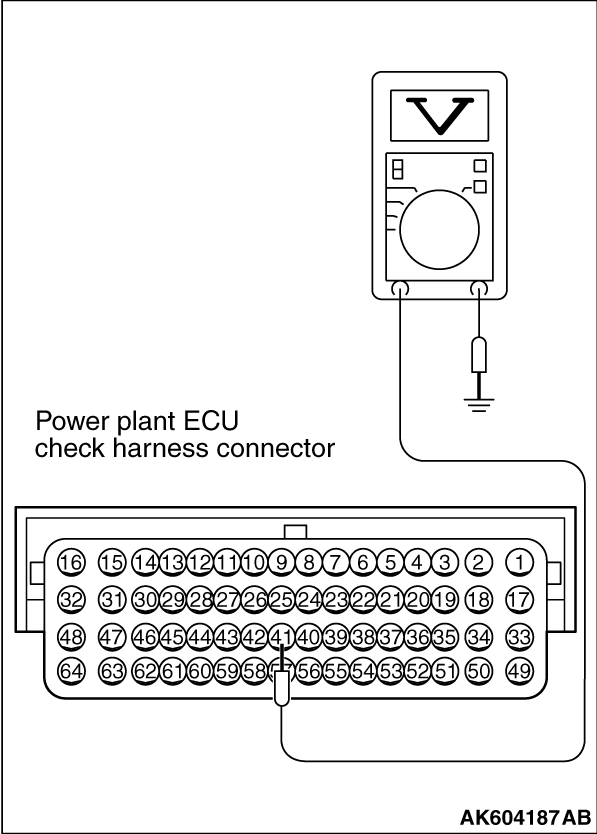
|
(3)Measure the voltage between terminal No. 41 and ground.
- Voltage should be between 0.4 and 0.6 volt.
(4)Turn the ignition switch to the "LOCK" (OFF) position.
Q.
Is the measured voltage between 0.4 and 0.6 volt?
 Go to Step 11. Go to Step 11.
 Go to Step 9. Go to Step 9.
|
|
|
STEP 9. Check for short circuit to power supply between heated oxygen
sensor (rear) connector D-40 (terminal No. 4) and ECM connector B-108 (terminal No. 41).
|
|
|
| note |
Check harness after checking intermediate connectors A-10 and C-37. If intermediate connectors
are damaged, repair or replace them. Refer to GROUP 00E, Harness Connector Inspection  .
Then go to Step 12. .
Then go to Step 12.
|
|
|
|
Q.
Is the harness wire in good condition?
|
|
|
 Go to Step 10. Go to Step 10.
|
|
|
|
|
|
 Repair it. Then go to Step 12. Repair it. Then go to Step 12.
|
|
|
|
|
|
STEP 10. Check for short circuit to power supply between heated oxygen
sensor (rear) connector D-40 (terminal No. 3) and ECM connector B-108 (terminal No. 40).
|
|
|
| note |
Check harness after checking intermediate connectors A-10 and C-37. If intermediate connectors
are damaged, repair or replace them. Refer to GROUP 00E, Harness Connector Inspection  .
Then go to Step 12. .
Then go to Step 12.
|
|
|
|
Q.
Is the harness wire in good condition?
|
|
|
 Go to Step 11. Go to Step 11.
|
|
|
|
|
|
 Repair it. Then go to Step 12. Repair it. Then go to Step 12.
|
|
|
|
|
|
STEP 11. Check the trouble symptoms.
|
|
|
(1)Carry out a test drive with the drive cycle pattern. Refer to Diagnostic Function -
OBD-II
Drive Cycle -
Pattern 23  . .
|
|
|
(2)Check the diagnostic trouble code (DTC).
|
|
|
 Replace the ECM (Refer to, Removal and Installation Replace the ECM (Refer to, Removal and Installation  ).
Then go to Step 12. ).
Then go to Step 12.
|
|
|
|
|
|
 It can be assumed that this malfunction is intermittent. Refer to GROUP 00, How
to Use Troubleshooting/ Inspection Service Points -
How to Cope with Intermittent Malfunctions It can be assumed that this malfunction is intermittent. Refer to GROUP 00, How
to Use Troubleshooting/ Inspection Service Points -
How to Cope with Intermittent Malfunctions  . .
|
|
|
|
|
|
STEP 12. Test the OBD-II drive cycle.
|
|
|
(1)Carry out a test drive with the drive cycle pattern. Refer to Diagnostic Function -
OBD-II
Drive Cycle -
Pattern 23  . .
|
|
|
(2)Check the diagnostic trouble code (DTC).
|
|
|
 Retry the troubleshooting. Retry the troubleshooting.
|
|
|
|
|
|
 The inspection is complete. The inspection is complete.
|
|
|
|
 .
.![[Previous]](../../../buttons/fprev.png)
![[Next]](../../../buttons/fnext.png)





 .
. .
. .
. .
.
 .
. Go to Step 2.
Go to Step 2. Repair or replace them. Refer to GROUP 00E, Harness Connector Inspection
Repair or replace them. Refer to GROUP 00E, Harness Connector Inspection  .
Then go to Step 12.
.
Then go to Step 12.
 Go to Step 4.
Go to Step 4. Replace the heated oxygen sensor (rear). Then go to Step 12.
Replace the heated oxygen sensor (rear). Then go to Step 12. Go to Step 5.
Go to Step 5. Repair or replace it. Refer to GROUP 00E, Harness Connector Inspection
Repair or replace it. Refer to GROUP 00E, Harness Connector Inspection  .
Then go to Step 12.
.
Then go to Step 12.

 Go to Step 8.
Go to Step 8. Go to Step 6.
Go to Step 6. Go to Step 7.
Go to Step 7. Repair it. Then go to Step 12.
Repair it. Then go to Step 12. Go to Step 11.
Go to Step 11. Repair it. Then go to Step 12.
Repair it. Then go to Step 12.

 Go to Step 11.
Go to Step 11. Go to Step 9.
Go to Step 9. Go to Step 10.
Go to Step 10. Repair it. Then go to Step 12.
Repair it. Then go to Step 12. Go to Step 11.
Go to Step 11. Repair it. Then go to Step 12.
Repair it. Then go to Step 12. .
. Replace the ECM (Refer to, Removal and Installation
Replace the ECM (Refer to, Removal and Installation  ).
Then go to Step 12.
).
Then go to Step 12. It can be assumed that this malfunction is intermittent. Refer to GROUP 00, How
to Use Troubleshooting/ Inspection Service Points -
How to Cope with Intermittent Malfunctions
It can be assumed that this malfunction is intermittent. Refer to GROUP 00, How
to Use Troubleshooting/ Inspection Service Points -
How to Cope with Intermittent Malfunctions  .
.  .
. Retry the troubleshooting.
Retry the troubleshooting. The inspection is complete.
The inspection is complete.